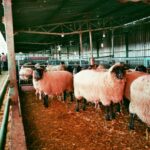The increasing focus on sustainability and rising energy costs make it crucial for farmers to adopt green energy solutions. Incorporating green energy into your farm’s equipment use not only reduces your environmental footprint but also enhances operational efficiency and saves money in the long run. Below are practical ways to integrate green energy into your farm’s equipment use.
1. Invest in Solar-Powered Equipment
Solar energy is one of the most accessible and cost-effective renewable energy sources. It can power irrigation systems, electric fences, and other farm equipment. Solar panels are particularly effective in sunny regions of South Africa.
How to Start:
- Install solar panels on rooftops, open fields, or even on portable platforms.
- Look for solar-powered options for water pumps, lighting, and monitoring systems.
2. Switch to Electric and Hybrid Machinery
Traditional tractors and other equipment rely heavily on diesel, which contributes to high greenhouse gas emissions. Electric and hybrid models are now available and are designed to be energy-efficient while maintaining high performance.
How to Start:
- Invest in electric tractors or utility vehicles for daily tasks.
- Use hybrid equipment during the transition phase to gradually reduce dependence on fossil fuels.
3. Utilize Biofuels
Biofuels, made from organic materials such as crop residues, animal waste, or specially grown crops like canola, are an excellent alternative to diesel. They can power tractors, generators, and other machinery.
How to Start:
- Partner with biofuel suppliers or explore producing your own biofuel using farm waste.
- Ensure that your existing equipment is compatible with biofuels or make necessary modifications.
4. Adopt Wind Energy for Stationary Equipment
Wind energy is another sustainable option for farms located in windy areas. Small wind turbines can generate enough electricity to power stationary equipment, such as grain elevators, feed mills, or water pumps.
How to Start:
- Assess your farm’s wind potential using professional consultation.
- Install small-scale wind turbines in open, windy areas for maximum efficiency.
5. Implement Smart Energy Management Systems
Smart energy systems allow you to monitor and optimize energy consumption across your farm, ensuring efficient use of green energy sources.
How to Start:
- Install sensors and energy monitoring devices on key machinery.
- Use apps or software to track energy usage patterns and identify areas for improvement.
6. Upgrade to Energy-Efficient Lighting
Switching to LED lighting systems for barns, storage areas, and outdoor spaces is a simple yet effective way to save energy. Solar-powered LED lights can further enhance sustainability.
How to Start:
- Replace incandescent or halogen bulbs with LEDs.
- Use motion sensors and timers to reduce energy consumption in low-use areas.
7. Recycle Waste for Energy Production
Waste-to-energy systems can convert manure, crop residues, or organic waste into biogas, which can be used to power machinery or generate electricity.
How to Start:
- Invest in a biogas digester suitable for the scale of your farm.
- Use the biogas for tasks like running generators or heating.
8. Leverage Government Incentives and Grants
South Africa offers various incentives and subsidies to encourage the adoption of renewable energy. Taking advantage of these can make incorporating green energy more affordable.
How to Start:
- Research available programs such as rebates for solar panel installation or subsidies for biofuel production.
- Apply for financing options designed for renewable energy investments.
9. Train Employees on Green Energy Practices
Your farm’s transition to green energy will be more successful if your team understands its importance and knows how to use and maintain new equipment.
How to Start:
- Conduct regular training sessions on operating solar-powered or electric machinery.
- Encourage employees to identify further opportunities for green energy use.
10. Collaborate with Sustainable Equipment Providers
Many companies specialize in energy-efficient and renewable-powered farm machinery. Collaborating with these providers ensures access to the latest technology tailored for your needs.
How to Start:
- Partner with suppliers offering eco-friendly equipment.
- Attend trade shows or workshops focused on sustainable farming innovations.
Integrating green energy into your farm’s equipment use is not only an investment in sustainability but also a step toward reducing costs and boosting efficiency. By adopting solar, wind, biofuel, and other renewable energy solutions, South African farmers can future-proof their operations and contribute to a healthier planet. Start small, assess your energy needs, and take advantage of available resources to make the transition seamless and impactful.
Join 'Farmers Mag' WhatsApp Channel
Get the latest Farming news and tips delivered straight to your WhatsApp
CLICK HERE TO JOIN






